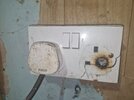- Joined
- 24 Nov 2004
- Messages
- 432
- Reaction score
- 5
- Country

Saw one of these tother day (see photo)
I've seen a few like this over the years, and it seems to be always the L conductor that cooks up. whenever Ive seen this, it's been in "known dodgy" situations (ie, where unregulated DIY shenanigans are continuously ongoing, with operators who are comfortable with a bit of risk)
Ive wondered, whenever Ive seen these, (and not having seen the exact installation that led up to the cookery) what causes it.
clearly it's caused by overheating around the L pin/socket interface. That could come from EITHER:
> >13A flowing in the L line but NOT in the N line, in which case, the current must be flowing to earth outwith the plug/socket circuit.
a resistive connection in (or near to) the L pin/socket interface.
I cant think of any other cause.
I guess my beef is that my first thought is forced overloading of the plug/socket, but that should result in both L & N cooking up. but I don't think Ive ever seen N cooked.
whats the explanation of why (in my experience) its only every the L pin thats fried?
I've seen a few like this over the years, and it seems to be always the L conductor that cooks up. whenever Ive seen this, it's been in "known dodgy" situations (ie, where unregulated DIY shenanigans are continuously ongoing, with operators who are comfortable with a bit of risk)
Ive wondered, whenever Ive seen these, (and not having seen the exact installation that led up to the cookery) what causes it.
clearly it's caused by overheating around the L pin/socket interface. That could come from EITHER:
> >13A flowing in the L line but NOT in the N line, in which case, the current must be flowing to earth outwith the plug/socket circuit.
a resistive connection in (or near to) the L pin/socket interface.
I cant think of any other cause.
I guess my beef is that my first thought is forced overloading of the plug/socket, but that should result in both L & N cooking up. but I don't think Ive ever seen N cooked.
whats the explanation of why (in my experience) its only every the L pin thats fried?

